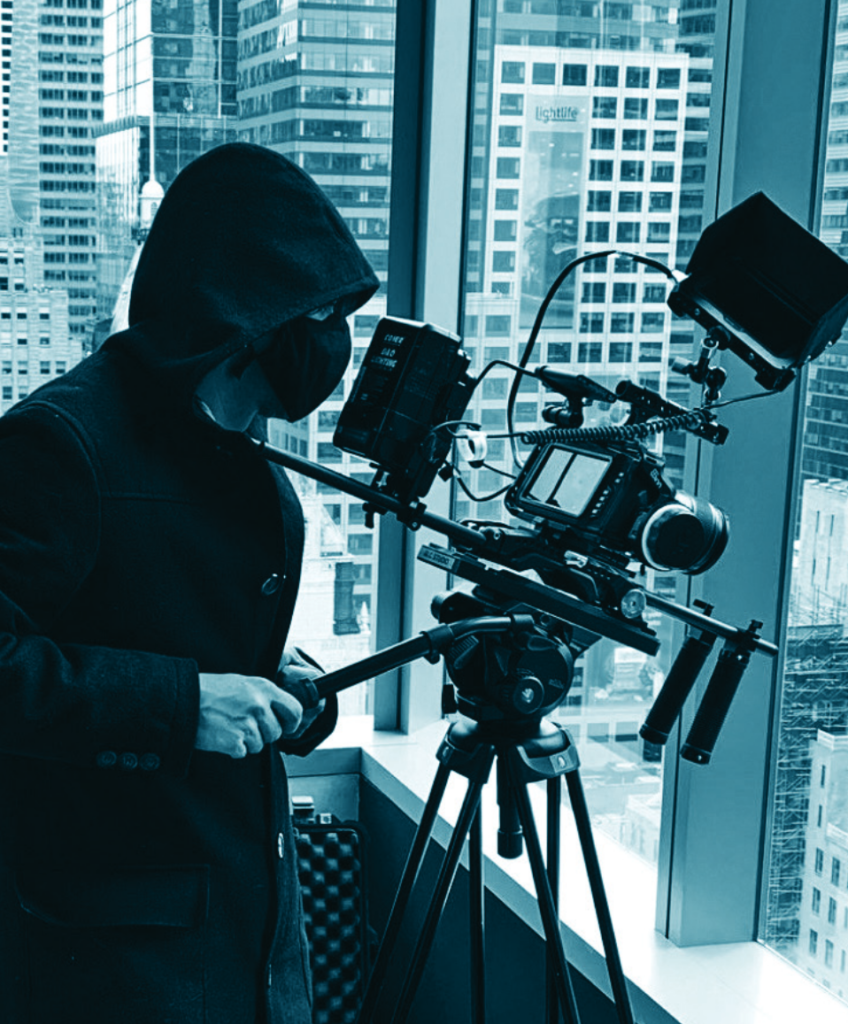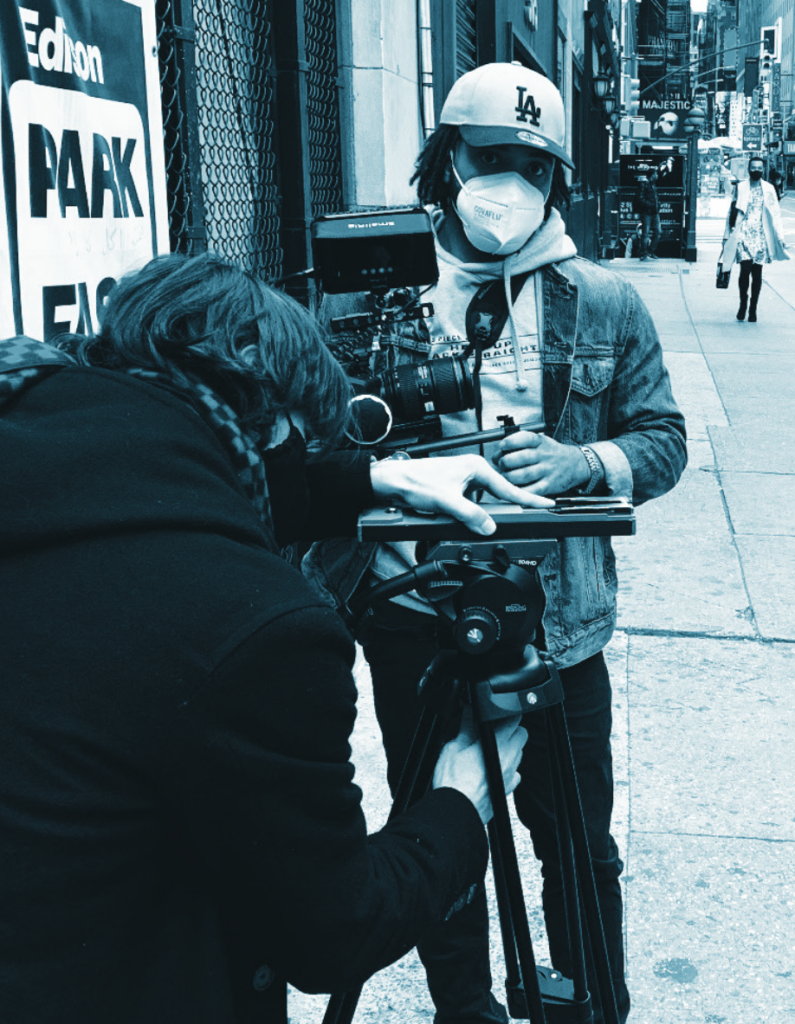
M&E Journal: Hollywood’s New Remote – and Virtual – Production Reality
For director and actor Ramon Fernandez (Glory Daze: The Life and Times of Michael Alig, “Sons of Anarchy”) the past year was challenging on all fronts, both around the production of a new documentary, and in doing voice-over and acting work.
“Producers now get to save the cost of renting a recording studio and demand that talent themselves invest in software and make a home studio in order to compete,” he said of the challenges COVID-19 has presented to voice actors.
But on the production front, Fernandez’s pandemic-era direction and editing work on the documentary See to Sea — about four blind athletes who crossed the U.S. coast-to-coast on tandem bicycles in just nine days — was a revelation: remote-access workflow and collaboration tools changed how projects are completed.
“We’ve learned a lot in the last year and much of it is cost-effective,” he said. “Many companies will remain as strictly virtual as possible. Not only is it safer, cheap-er and less time-consuming, but we’ve all been trained over the last year on how to do it, because we had to. On-set protocol will probably lax with time, but I think collective paranoia about invisible germs will probably remain to some degree, long after COVID-19.”
 The pandemic had Mark Harris, director and writer of the recently released comedy film White People Money, in a different position than Fernandez: his film was already in the can, having wrapped up post-production just as COVID-19 shut Hollywood down.
The pandemic had Mark Harris, director and writer of the recently released comedy film White People Money, in a different position than Fernandez: his film was already in the can, having wrapped up post-production just as COVID-19 shut Hollywood down.
Harris had to make the same choice many major studios had for their major releases: either sit on the release altogether, or go digital first, and close the window between theatrical and in-home consumption like never before.
“I think the pandemic forced us to make changes, and those changes, especially for independent filmmakers, could be used to our advantage,” Harris said. “If a studio film is released on streaming or VOD at the exact same time as an independent film this levels the playing field, because the consumer doesn’t have to leave their home to choose between an independent or studio [release]. They can make that decision from their living room.”
For both of those filmmakers — and so many like them across the industry — the past year-plus has resulted in a monumental shift in how content is both produced and distributed. And even when the pandemic ends, the way film-making is done has likely forever changed because of it.
The new status quo
The use of virtual production techniques — melding live-action with computer graphics in real time, often with the help of powerful game engine platforms — existed before the pandemic, with Technicolor’s visual effects house MPC’s work on 2019’s The Lion King being among the more notable occasions where a physical set wasn’t needed. Among all the media and entertainment advances to emerge from the pandemic — remote workflows, a heavier reliance on cloud technologies, the use of artificial intelligence (AI) and machine learning (ML) tools to automate and streamline key production tasks — it was the promise of virtual production that MESA members seemed most excited about.
“The key benefit of reducing the need to travel for on location shooting has given virtual production a material boost in financial viability,” said Sohonet CEO Chuck Parker. “While the pandemic persists, virtual stages are both a means to continue production safely and to reduce the cost of on location work. If the practical effects delivered via virtual production can reduce the overall VFX budget for productions as promised, then this trend will accelerate rapidly.”
The upfront capital cost of virtual production technology is expensive (and the techniques have yet to be embedded throughout workflows), so Parker expects only modest growth for the technology this year. “The winners in the race to virtual production will be the businesses that can perform at scale with the available capital to invest in the resources required to support this industry pivot while re-invigorating their core VFX business,” he added.
Jack Watts, VP of technology for Miami-based localization provider The Kitchen, called virtual production a “game-changer “for the industry, specifically for the independent film community.
“Games engines such as Unity and Unreal Engine have evolved to the point of being able to deliver 4K photo-real graphics and high frame rates, and when coupled with the open-source community, will allow any small-to-medium film-making team, with a decent level of technical prowess, access to a medium of storytelling where you would have previously been limited by your budget,” he said.
That’s music to the ears of Edward Churchward, co-founder and CTO of Arch Platform Technologies, which provides 100 percent cloud-based VFX and post-production pipelines using Amazon Web Services (AWS) and IBM Cloud.“
“The largest shift has been that now VFX and film production studios see the value of having remote teams and enabling them to continuously work in a secure, fully virtualized environment that maintains the integrity of the original content,” he said. Moving production and post workflows to the cloud also means faster review and iteration in the VFX process, especially when tools are integrated in the same cloud environment.”
When the pandemic arrived, the shutdown of productions meant the death of several VFX firms, many stuck with large overhead costs for empty offices and the transfer of equipment to artists’ homes during lockdown.
Being in a virtual environment, however, showed VFX and production teams that physical work-stations aren’t required to achieve the best visual effects, Churchward said.
“We are seeing the advent of a time when you won’t need to shoot a scene, send a frame for VFX, and make adjustments in post-production,” he said. “Directors will instead be able to see on their screen, as they film, the 3D monster or whatever effects they want. Instead of post-production, most VFX will be done pre-production, with filmmakers waiting to start shooting until all effects are done so they can see their complete vision as they film.”
 Remote everything
Remote everything
AWS made industry-wide waves in late April with the launch of AWS for Media & Entertainment.
The initiative is geared toward making it easier for media and entertainment customers to implement and deploy purpose-built AWS capabilities and partner solutions, and comes with Amazon Nimble Studio, a new suite of tools that enable customers to produce content entirely in the cloud, and create a functional creative studio in hours.
“The new suite of Amazon Nimble Studio tools, combined with the power of AWS for Media & Entertainment services, gives customers access to onboard and collaborate with artists from anywhere in the world, and make, distribute and archive features and episodic series entirely in the cloud, eliminating the expense of a studio build-out,” AWS announced in a statement, adding that more than 400 AWS partner offerings were included.
It’s yet another advancement during the pandemic for media and entertainment that promises to be around long after COVID-19 is no longer hindering the industry.
“Cloud-based remote production is the future of movie-making,” said Allan McLennan, chief executive and founder of M&E consulting firm PADEM Media Group. “It empowers and provides the creative community production workflows that now can enable frictionless remote collaboration and content creation. Teams be they large houses or small, producers, direc-tors and writers or independents can easily connect, contribute and advance projects.”
He said the industry has recognized that virtualized and remote production is a welcome path toward delivering on the needs of today’s content consumption demands and “what is now key, in order to deliver on this promise, is the immense need is to have an in-depth understanding, expertise and clarity on how all of this fits together, in order to build and meet these goals head on and deliver on these ambitions.”
Ian Main, technical marketing principal at remote workspace specialist Teradici, said the past year proved that the remote desktop user experience can be exactly the same as being in front of any studio workstation. “This might sound simple, but it’s a huge advancement for media and entertainment, and similar industries like game development, which may have been skeptical in the past of remote production meeting their very specific security and performance needs,” he said. “Now they’ve experienced it for themselves, and we’ve heard many, many success stories.”
That includes Canadian game developer Relic Entertainment’s de-signers and artists remaining productive while working from home during the pandemic, and VFX studios such as Hive VFX, JellyFish Pictures and Untold Studios successfully leveraging public cloud workstations to increase geographic access to talent, enable rapid scaling, and shift to OPEX-oriented, on-demand operations.
“We’ve seen M&E customers like Technicolor launch mission-critical workloads from across the globe, encompassing visual effects, animation, post production and all other aspects of their business,” Main said. “Remote work will be a mainstay for most of our customers, including for production workflows, because it helps them be more efficient with how they get the work done, and provides a lot of flexibility to attract and retain employees, as well as to leverage global talent and contractors.”
Russell Wise, SVP of sales and marketing for Digital Nirvana, developer of AI- and ML-powered knowledge management solutions for M&E, said remote production is here to stay, and the pandemic merely accelerated video producers’ adaptation to remote collaboration workflows, without sacrificing production continuity.
Well before the pandemic, advanced AI and ML tools “were beginning to transform virtually every aspect of content creation and distribution — bringing new levels of accuracy, efficiency, compliance, and cost savings to media operations,” he said. “And now, AI-based tools delivered in the cloud are facilitating a broad range of remote tasks throughout the content lifecycle, from acquisition and contribution to post-production and then final distribution on a variety of platforms,” Wise said.
“By automating the process of capturing metadata for large volumes of content, AI and ML technologies replace burdensome manual processes and save media organizations countless hours of manual work.”
From content enrichment to repurposing and localization, quality assurance and compliance to monitoring, AI and ML tools are automating and streamlining key production tasks in remote environments, he added.
“For the most part, the technology that makes virtual and remote productions possible had already existed,” said Eric Wynalek, VP of strategic initiatives for cloud-based media collaboration and digital asset management solutions provider Shift. “We haven’t reinvented the wheel here. What this past year has forced us all to do is think about that technology differently, and be creative with how we use it to solve these new problems. I’ve been especially inspired to see the enormous power and responsibility that has been taken by on-screen talent to self-shoot their own footage, and how directors, gaffers, and cinematographers have had to become virtual teachers to create the shots they want at the hands of someone else.”
 There are always new changes on the horizon of the production industry, because production is innovative by nature, whether in response to a crisis or simply for innovation’s own sake, Wynalek said. Remote feeds and off-site video villages are likely here to stay long after this pandemic is over.
There are always new changes on the horizon of the production industry, because production is innovative by nature, whether in response to a crisis or simply for innovation’s own sake, Wynalek said. Remote feeds and off-site video villages are likely here to stay long after this pandemic is over.
“This past year has proven that remote options are viable, and there’s no need to go back,” he said.
Locking it all down
Any discussion around working on productions remotely invariably results in questions around just how secure everything is, from the physical level to the entire digital workflow.The short answer: that depends.
“With the move away from physical security within an office, individual companies were forced to make decisions on how they would monitor assets in the field and from home offices,” said John-Thomas Gaietto, executive director of cybersecurity services for Richey May Technology Solutions. “We’ve seen everything from companies requiring video cameras on individuals within their homes while they work to nothing at all.”
As it relates to the digital workflow, many companies are struggling to protect their endpoint computers with basic blocking and tackling, such as patches and local firewalls, he added.
That’s because, traditionally, security controls were designed to be centralized within an office. Computers going home meant companies had to make compromises between being able to keep working and strong cyber controls.
This past year, some companies adapted and moved their entire workflow to the cloud using virtual computing platforms, to manage assets from production to post production.
“We’ve seen a large increase in these types of solutions,” Gaietto said. “Better yet it’s opened the playing field up for start-ups like Klio Studio that are attempting to create a complete platform that manages the life cycle of a project from pre- to post-production, including the assets as they move through a digital production cycle.”
In the future, productions can utilize a single platform from pre-production to manage scripts, to shooting schedules, to managing assets, as they are created, and then shared (via cloud storage) to specific post-production resources.
From a security standpoint, the flexibility of working from home may be the first line of what stays or goes, Gaietto added, with some companies already planning on bringing everyone back, and others are evaluating based on the employment role.
Mathew Gilliat-Smith, EVP for M&E security, risk and compliance services firm Convergent Risks, said no matter what path productions take going forward, content companies better have the right guidelines in place.
“When rapidly deploying new SaaS applications, regardless of whether remote productions are here to stay or not, if specific hardening guidelines could be made readily available, it would go a long way in helping to prevent configuration errors, and ensuring production environments are set up more securely,” he said. “Until production footage is safely uploaded to the cloud environment or dailies vendor, assets still need supervision — especially if there are less people around on remote productions. Even a low-resolution copy accidentally finding its way to social media can be very damaging.”
Changes in consumer behavior may have had the biggest impact on how the industry approached protecting content during the pandemic, and should continue to be a factor moving forward, according to Alan Ogilvie, lead product manager for Friend MTS, which provides platform, channel and content protection services.
 To keep up with consumer demand and expectations, many content owners, broadcasters and operators are realizing the need to incorporate an end-to-end approach to piracy, one that includes monitoring and takedowns, as well as insights to identify tendencies and trends of bad-actors within subscriber bases.
To keep up with consumer demand and expectations, many content owners, broadcasters and operators are realizing the need to incorporate an end-to-end approach to piracy, one that includes monitoring and takedowns, as well as insights to identify tendencies and trends of bad-actors within subscriber bases.
“Producers and distributors will continue to experiment with new acquisition and release workflows, potentially changing the outlook of how content protection technologies are implement-ed,” he said. “Early release windows, or tightened release windows, will likely continue in some form for premium VOD services such as Disney+, Prime Video and HBO Max, among others.
Efficiencies have been gained within the media industry thanks to the work-from-home culture, which has affected best practices on ways to move video around in a more secure fashion. Now, media asset managers see the need to develop strategies on where and when protection measures are put into place to effectively manage, store and distribute their digital assets safely.”
If the pandemic has proven anything, it’s that remote working with media assets is a security challenge that will need to be navigated in new ways, according to Lee Griffiths, COO of digital content protection solutions firm Fortium Technologies.
“It’s emphasized the need for businesses to adapt to new ways of working. Solutions that secure content outside of the usual protections of a tightly controlled working environment are an essential part of future, modern working.”
* By Chris Tribbey, Editorial Director, MESA
=============================================
Click here to download the complete .PDF version of this article
Click here to download the entire Spring 2021 M&E Journal
